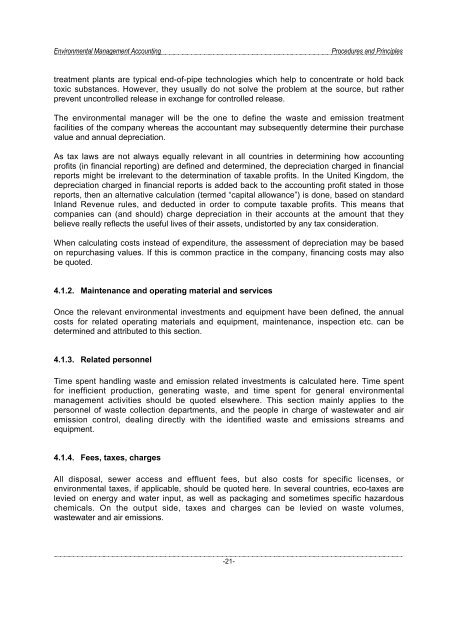Environmental Management Accounting Procedures and Principles
Environmental Management Accounting Procedures and Principles
Environmental Management Accounting Procedures and Principles
You also want an ePaper? Increase the reach of your titles
YUMPU automatically turns print PDFs into web optimized ePapers that Google loves.
<strong>Environmental</strong> <strong>Management</strong> <strong>Accounting</strong><br />
<strong>Procedures</strong> <strong>and</strong> <strong>Principles</strong><br />
treatment plants are typical end-of-pipe technologies which help to concentrate or hold back<br />
toxic substances. However, they usually do not solve the problem at the source, but rather<br />
prevent uncontrolled release in exchange for controlled release.<br />
The environmental manager will be the one to define the waste <strong>and</strong> emission treatment<br />
facilities of the company whereas the accountant may subsequently determine their purchase<br />
value <strong>and</strong> annual depreciation.<br />
As tax laws are not always equally relevant in all countries in determining how accounting<br />
profits (in financial reporting) are defined <strong>and</strong> determined, the depreciation charged in financial<br />
reports might be irrelevant to the determination of taxable profits. In the United Kingdom, the<br />
depreciation charged in financial reports is added back to the accounting profit stated in those<br />
reports, then an alternative calculation (termed “capital allowance”) is done, based on st<strong>and</strong>ard<br />
Inl<strong>and</strong> Revenue rules, <strong>and</strong> deducted in order to compute taxable profits. This means that<br />
companies can (<strong>and</strong> should) charge depreciation in their accounts at the amount that they<br />
believe really reflects the useful lives of their assets, undistorted by any tax consideration.<br />
When calculating costs instead of expenditure, the assessment of depreciation may be based<br />
on repurchasing values. If this is common practice in the company, financing costs may also<br />
be quoted.<br />
4.1.2. Maintenance <strong>and</strong> operating material <strong>and</strong> services<br />
Once the relevant environmental investments <strong>and</strong> equipment have been defined, the annual<br />
costs for related operating materials <strong>and</strong> equipment, maintenance, inspection etc. can be<br />
determined <strong>and</strong> attributed to this section.<br />
4.1.3. Related personnel<br />
Time spent h<strong>and</strong>ling waste <strong>and</strong> emission related investments is calculated here. Time spent<br />
for inefficient production, generating waste, <strong>and</strong> time spent for general environmental<br />
management activities should be quoted elsewhere. This section mainly applies to the<br />
personnel of waste collection departments, <strong>and</strong> the people in charge of wastewater <strong>and</strong> air<br />
emission control, dealing directly with the identified waste <strong>and</strong> emissions streams <strong>and</strong><br />
equipment.<br />
4.1.4. Fees, taxes, charges<br />
All disposal, sewer access <strong>and</strong> effluent fees, but also costs for specific licenses, or<br />
environmental taxes, if applicable, should be quoted here. In several countries, eco-taxes are<br />
levied on energy <strong>and</strong> water input, as well as packaging <strong>and</strong> sometimes specific hazardous<br />
chemicals. On the output side, taxes <strong>and</strong> charges can be levied on waste volumes,<br />
wastewater <strong>and</strong> air emissions.<br />
-21-




